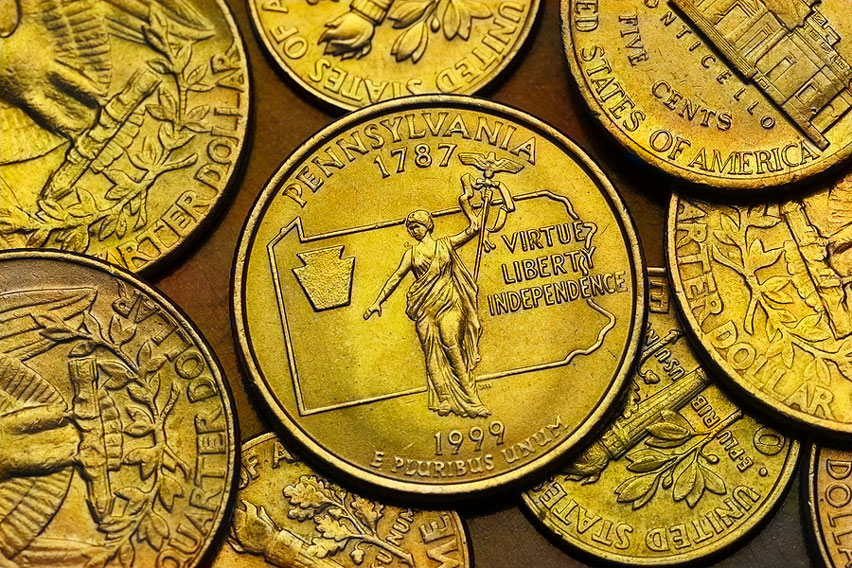 Gold-plated quarters are often advertised as valuable and rare precious metals investments on par with legitimate gold coins. Unfortunately, this misleading claim continues to convince large swathes of the population to invest their hard-earned money into novelty coins with no added value beyond the coins face value. Understanding the difference between gold-plated quarters and genuine gold coins is crucial for building a properly diversified, secure, and valuable precious metals portfolio.
Gold-plated quarters are often advertised as valuable and rare precious metals investments on par with legitimate gold coins. Unfortunately, this misleading claim continues to convince large swathes of the population to invest their hard-earned money into novelty coins with no added value beyond the coins face value. Understanding the difference between gold-plated quarters and genuine gold coins is crucial for building a properly diversified, secure, and valuable precious metals portfolio.
What is a gold-plated quarter?
Gold-plated quarters are standard American quarters that have been modified with a thin coating of gold. This is done purely for commemorative or decorative reasons. Gold-plated quarters aren’t intended to be used as stores of wealth by investors. Instead, they’re designed as collectibles, novelties, or souvenirs.
It’s worth noting that the U.S. Mint has never produced gold-plated quarters. Instead, these unofficial items are sold by private mints that apply a thin layer of gold to regular circulating quarters. Gold’s ductility – the ability to be stretched and reshaped – makes it possible for private mints to completely cover quarters with a virtually worthless amount of gold. The layer of gold on most gold-plated quarters is 15 millionths of an inch. In other words, if a gold-plated quarter was cut in half, the layer of gold would be imperceptible to the naked eye.
Any run-of-the-mill quarter has the potential to be converted into a gold-plated quarter. Usually, private mints focus on specific themes or designs to increase the collectible appeal of these coins.
Are gold-plated quarters worth anything?
Gold-plated quarters aren’t worth anything beyond their denominational worth of $0.25. Many investors have been disheartened to learn that a gold-plated quarter they’ve purchased isn’t worth any more than other U.S. quarters. The amount of gold needed to cover a quarter is incredibly small which translates into negligible intrinsic value. Besides, the cost of melting down and extracting the gold from a gold-plated quarter would far exceed the value of its precious metals contents.
However, this doesn’t keep some questionable sellers from artificially inflating the prices of gold-plated quarters. By highlighting their limited production and pristine condition, these sellers can convince buyers that gold-plated quarters are a worthwhile investment. In reality, scarcity and appearance alone aren’t enough to confer inherent value. This is an issue with modern graded bullion coins too.
Downsides of Gold-Plated Quarters
No inherent value
One of the primary reasons investors seek out gold coins is to hedge against inflation, volatility, and other market instability. Gold-plated quarters don’t meet this threshold because of their low purity. While standard bullion gold coins boast a purity rating of 90% and higher, gold-plated quarters have an effectively worthless amount of gold. This lack of inherent value means these modified coins offer no protection from economic uncertainty.
High premiums
Gold-plated quarters are commonly sold with exceedingly high premiums far beyond their value. Although dealer premiums are standard in the precious metals industry, gold-plated quarters tend to receive unreasonably eccentric markups. This significant add-on cost combined with a lack of appreciation makes it nearly impossible for investors to recoup their investments.
Low liquidity
Typically, gold assets enjoy high liquidity due to this metal’s widespread adoption, universal recognition, and high intrinsic value. Since gold-plated quarters are more novelty items than investment assets, they don’t experience nearly the same demand. It’s decidedly difficult to find a buyer when looking to resell these collectibles.
The Legality of Gold-Plated Quarters
Gold-plated quarters raise an interesting question regarding the repercussions of modifying official currency. Generally, altering coinage is fine as long as it’s not fraudulently advertised as legal tender. Gold-plated quarters, similar to pressed pennies, are well-understood to be merely collectible items rather than usable currency. However, this doesn’t bar some sellers from implying that gold-plated quarters make worthwhile investments despite their lack of inherent value.
Gold-Plated Quarters vs Gold Coins
There’s a crucial distinction between gold-plated quarters and legitimate gold coins. While gold-plated quarters are standard quarters with a thin veneer of gold, proper gold coins are bullion or rare coins with investment value. These gold coins are characterized by impressive fineness ratings, high demand, and inherent value which make them reliable hedges against inflation and preserves of wealth. Investors looking to diversify their portfolios with tried-and-true precious metals assets should focus on gold coins rather than novelty items.
If you’re interested in learning more about securing your wealth with gold assets, grab a copy of our FREE Precious Metals Investment Guide. It covers everything you need to know about diversifying your portfolio, leveraging inflation, and securing your nest egg.


